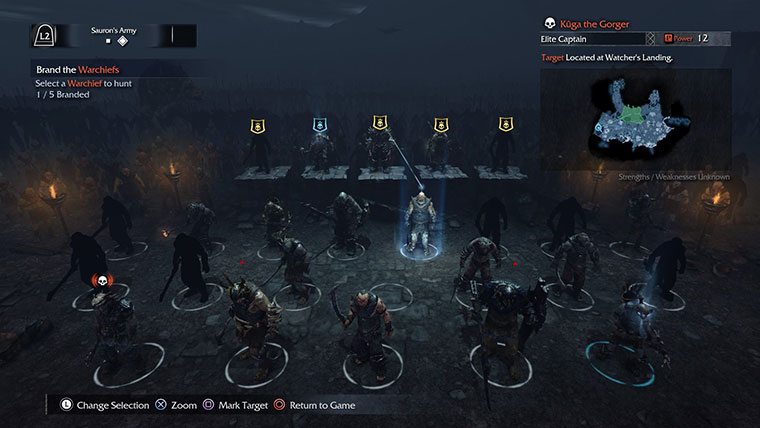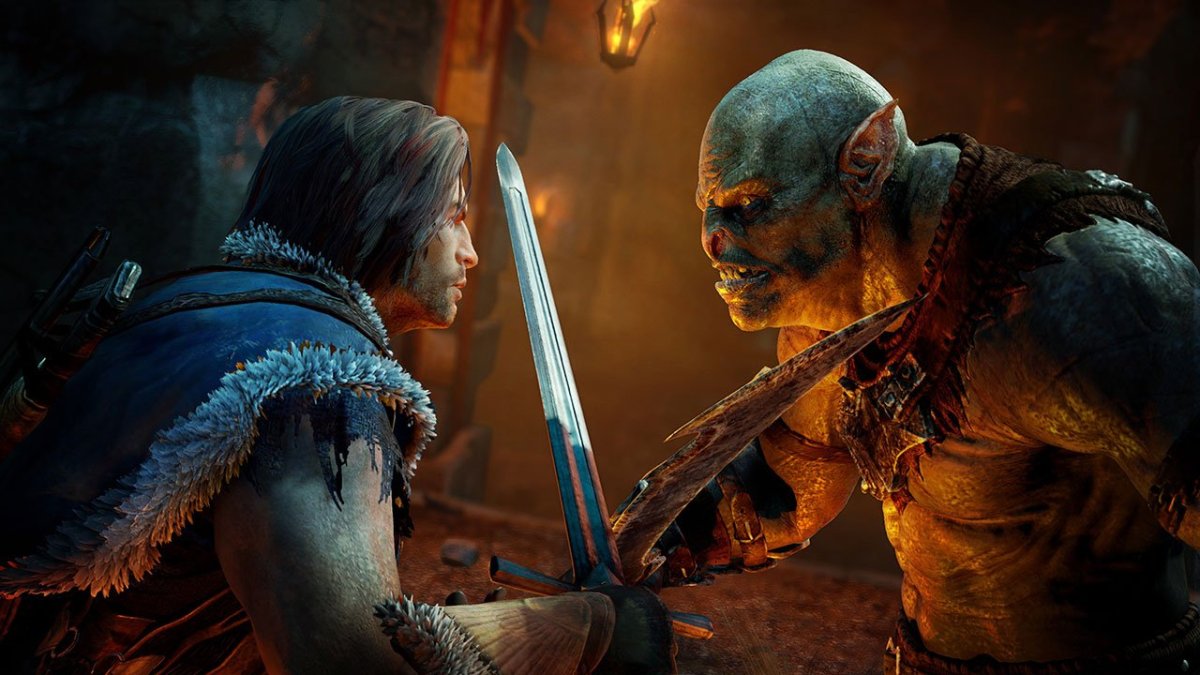Middle Earth: Shadow of Mordor is a tale of two games. One is an open-world game, the likes of which is built on the pillars of other popular open-world franchises like Assassin’s Creed or the Batman: Arkham series. In fact, Monolith Productions takes many aspects of these two popular game franchises and makes them their own for Shadow of Mordor. The other is something that we haven’t quite seen before, it’s a new and impressive system of AI called “The Nemesis System”, which populates Mordor with an unprecedented level of intelligent characters and a hierarchy of enemies to tackle. Middle Earth: Shadow of Mordor is one part wholly familiar retread into story telling and open world gameplay conventions, and one part a new and refreshing injection of great ideas and underlying systems.
Monolith is no stranger to the Lord of Rings series. Their 2012 release of Guardians of Middle Earth on PS3 and Xbox 360 was a fairly cookie cutter attempt at jumping into the MOBA genre, the hook being that players could use characters from the popular series of movies and books. While the game was received favorably, including our review, Guardians of Middle Earth felt more like a game that was made to capitalize on the impending theatrical release of The Hobbit. Middle Earth: Shadow of Mordor isn’t this. It’s not a movie tie-in game, although it’s certainly working with licensed material. Shadow of Mordor focuses more acutely on unknown characters in the The Lord of the Rings universe, namely Talion, an undead Ranger on a revenge quest against the minions of Sauron.

However, Middle Earth: Shadow of Mordor isn’t necessarily a story just for The Lord of the Rings fans. Hard core enthusiasts of Tolkien’s original works will likely scoff at deviations from canon, and those that have only the movies to go on will get very little exposition or elaboration on the stories of the movies in this video game. It’s a weird middle ground that Shadow of Mordor walks in the story department, and because of it, the game can feel somewhat generic at times. Talion, the Ranger, has been murdered alongside his family, and he’s been banished from death. Due to this, Talion exists in both the world of the living and the dead. He can interact in the real world, as well as in a spirit world. This doubles as a good reason for why the Ranger can resurrect repeatedly and jaunt between the world of the living and dead at the click of a button. Story just isn’t the star of the show here. It’s one that we’ve heard before in some form or fashion, and there are very few memorable characters and instances where the story is ushered along with informative cinematics or story building dialogue between characters. From open to end, the story of Middle Earth: Shadow of Mordor is flat, it’s characters fairly generic, and leaves many questions unanswered, before screeching to an abrupt halt.
Shadow of Mordor takes some of the best ideas in open world game development and makes them its own in this game. Exploration features like climbing towers to reveal areas in full, and general traversal of the land feel distinctly like other games of this type. If you’ve played any popular open world game in the last decade, you’ll be familiar with what your objective is in Shadow of Mordor — set your marker, run to the mission, stab an Orc. There are a number of story missions and side missions to accomplish in this game. These have a wide range of objectives to complete using the Ranger’s skill set of both stealth and brutality. Almost all of them include the combat elements of the game, which are distinctly ripped from Batman Arkham. While there have been many to ape the systems of Rocksteady over the years, Shadow of Mordor’s combat is more enjoyable than most. The combat will flow in a similar fashion, allowing you to fight many, many enemies at once, while using button prompts to counter and transition between adversaries. It features many of the same classes of enemies that Batman has in the past, making you utilize different moves that Talion has to break guard. Unlike Batman though, there are few visual queues in the enemy design as to which of them require special attacks, making it a little confusing among what can be, at times, a sea of enemies. Combat itself is brutal, and quite possibly the best playing sword fighting combat of this type. Talion has numerous finishing moves, brutal execuctions which include repeated slashing, stabbing, and even beheading animations.

While Talion is an apt combatant, many missions will require the use of stealth. Sneaking up on enemies and dispatching them quietly is always an option, regardless of mission objectives. Utilizing a spirt world mechanic, Talion can see the enemies that surround him, plot paths accordingly, and see environmental hazards that he can use to level the playing field. He can also use a bow and arrow in this mode, which can be used to incapacitate foes straight forward, or use environmental aspects like bonfires to blow up groups of enemies. There’s a big sandbox aspect to Shadow of Mordor, like many open world games, and the freedom to tackle problems in the way the player sees fit, is always fun to tinker with.
So this sounds about like every other open world game that’s come out in the last few years, right? Well, in many ways, it is. As stated, there are a number of similarities in the gameplay of Mordor and other open world games. The hook, or what separates this game from others of its type, is The Nemesis System. It’s a system of AI that seemingly runs in parallel to what you are doing in the game. Orcs or the Uruk, dominate Mordor and they’ve got a completely functional hierarchy to carry out this map wide domination. Led by Warchiefs, supported by a network of Captains and the grunts they command, the Nemesis System adds an interesting wrinkle to the world of Mordor. It’s a more realistic battlefield, where you won’t just encounter pre-determined enemies of specific difficulty levels in designated areas.

These Captains and Warchiefs are roaming the world of Mordor and they are significantly more powerful enemies than the lowly grunts. They are waging war within their own ranks, rallying troops, boosting morale and growing stronger alongside you. They have strengths and weakness, they have seemingly randomly generated appearances and names. Some are imposing figures, some are easily underestimated. These Orcs can move through the ranks by defeating you, and defeating each other in duels, and of the many side missions in Shadow of Mordor, its your job to impede this process.
It’s done in a number of ways. The map is littered with ongoing events where Captains are rallying troops, feasting, dueling each other in power plays, and possibly just walking around. You’ll impede progress by completing these side missions, and there are numerous ways to accomplish these objectives. Some are as simple as disturbing an ongoing event, others will let you choose a side to help in a duel. In any event, it’s an interesting facet to have such an impact on the enemies that you’ll be facing going forward, leaving a more personal feel to the game in general, knowing that your decisions, actions, or inaction leave a lasting mark.
Dying or failing to stop these ongoing events will leave a mark as well. Time will progress, Orcs will rise through the ranks. They will get stronger and more formidable when you encounter them next. They’ll make snide remarks making it known that they’ve bested you before, making it all the more sweet when their heads go rolling off their shoulders.

It won’t be easy to tackle such a vast network of varying enemies. It’s just not as simple as walking up and stabbing the higher level Uruk. They’ve all got unique strengths and weaknesses. The Nemesis System does allow Talion to secure intel about the Orc army though, which reveals these different attributes, alliances or bodyguards, and their locations. It’ll make tackling Warchiefs more manageable, as without it, it’s very easy to be overwhelmed by multiple high level characters.
In its second act, Mordor’s Nemesis System opens even further, allowing players to recruit and build their own army of Orcs to take on an even greater threat as you push towards the end game. Recruiting these Captains and Warchiefs will make them fight for you when near, coupled with tamable animals to form a formidable army. The Nemesis System is indeed fun, and fresh. It’s something that pushes this type of game forward, but it’s absolute impact on Shadow of Mordor leaves something to be desired when the credits roll. The payoff just isn’t there in the back third and final battle, where your hard work of building such an army should be rewarded with something greater.

While the Nemesis System is most unlike anything in conventional open-world games, Shadow of Mordor does offer a lot of the comforts that players have to come to expect in them, which includes a deep system of character ability progression, weapon runes which impact the three core weapons in various ways, and a currency system which allows the purchase and unlock of Rune slots, and player attributes, like greater starting health. Some of this is tied back into the Nemesis System, which rewards players for killing Warchiefs and Captains, giving them powerful Runes only found by slaying these enemies. Most, if not all of the missions, side and main, will reward you with some sort of meaningful progression for Talion. The end result is a more powerful warrior, tailored towards the player’s tastes.
This progression system makes scavenging each part of the two open world maps a must, and climbing each tower to discover all there is to see. Similar to the Assassin’s Creed/Far Cry model of expanding the view of a map when tower checkpoints are made, Mordor rewards players with the ability to see all missions or collectibles in an area when a tower is ascended and unlocked. Collectibles in Shadow of Mordor are also strewn throughout the world, and do add some color to an otherwise bland storyline. Characters are given full written descriptions of who they are and what role they play in the story, it’s arguable as to what explains these people better, their written bios or the game itself. Further color is added by artifacts and visions that Talion will encounter. These extras to unlock and discover add a lot of additional time to be spent in the world, as is the case for many games of this type, if the player is so inclined to see and do everything. The main storyline in Shadow of Mordor can be completed in around 15-16 hours, and that feels pretty short for an open world game. Add in all the collectibles, as well as time you could spend in the Nemesis System, and you could certainly be looking towards a 40 hour experience.
The Verdict
Shadow of Mordor’s Nemesis system is the most interesting thing about this game, and we’ve likely seen the last of systems of this type. Visual fidelity, frame rates, and resolution have been the top selling points for many games that follow identical, popular formulas, lately. Monolith shakes things up in Middle Earth: Shadows of Mordor to make this open world game more refreshing than most.











Published: Oct 1, 2014 01:14 am